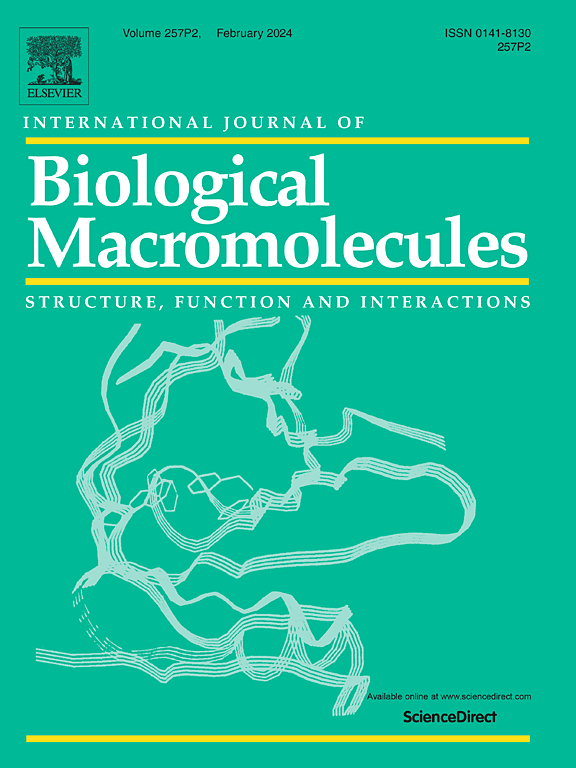利用一种具有遗传特征的欧氏komagataebacter菌株从米糠中生产高产细菌纤维素
IF 8.5
1区 化学
Q1 BIOCHEMISTRY & MOLECULAR BIOLOGY
International Journal of Biological Macromolecules
Pub Date : 2025-04-17
DOI:10.1016/j.ijbiomac.2025.143201
引用次数: 0
摘要
对一株高产的europaeus Komagataeibacter KFET1菌株利用米糠作为细菌纤维素(BC)生产底物的能力进行了评估。采用优化后的酶解方法,稻膜衍生BC (RB-BC)的产率达到15.67 g/L,比hestrin - schramm衍生BC (HS-BC)提高389.06%。通过FTIR、SEM、DSC、x射线衍射和固态核磁共振分析,RB-BC表现出优异的纳米纤维均匀性、再水化能力和热稳定性。在15 L生物反应器中放大发酵,BC产率为20.69 g/L,糖转化率为87.85%。高BC产量(20.69 g/L)源于KFET1菌株增强的碳水化合物代谢(264个基因)和酶解驱动的米糠营养物质释放之间的协同作用。经济分析显示,米糠培养基的利润为1166.42美元/吨,大大超过Hestrin-Schramm(- 153.06美元/吨)和椰子汁(906.33美元/吨)的价值,突出了米糠的成本效益。该研究为将农业副产品转化为高价值生物材料提供了一种有效和可持续的策略,为工业规模的BC生产铺平了道路。本文章由计算机程序翻译,如有差异,请以英文原文为准。

High-yield bacterial cellulose production from rice bran using a genetically characterized Komagataeibacter europaeus strain
A high-yielding Komagataeibacter europaeus strain, KFET1, was evaluated for its capacity to utilize rice bran as a cost-effective substrate for bacterial cellulose (BC) production. By employing an optimized enzymatic hydrolysis approach, the yield of rice bran-derived BC (RB-BC) reached 15.67 g/L, a 389.06 % improvement over Hestrin-Schramm-derived BC (HS-BC). RB-BC demonstrated superior nanofiber uniformity, rehydration capacity, and thermal stability, confirmed by FTIR, SEM, DSC, X-ray diffraction, and solid-state NMR analyses. Scale-up fermentation in a 15 L bioreactor achieved a BC yield of 20.69 g/L and a sugar conversion rate of 87.85 %. The high BC yield (20.69 g/L) stems from synergistic interactions between the KFET1 strain's enhanced carbohydrate metabolism (264 genes) and enzymatic hydrolysis-driven nutrient release from rice bran. Economic analysis demonstrated a profit of 1166.42 USD/ton for rice bran medium, significantly exceeding values for Hestrin-Schramm (−153.06 USD/ton) and coconut water (906.33 USD/ton), highlighting rice bran's cost-effectiveness. This study provides an efficient and sustainable strategy for converting agricultural by-products into high-value biomaterials, paving the way for industrial-scale BC production.
求助全文
通过发布文献求助,成功后即可免费获取论文全文。
去求助
来源期刊
CiteScore
13.70
自引率
9.80%
发文量
2728
审稿时长
64 days
期刊介绍:
The International Journal of Biological Macromolecules is a well-established international journal dedicated to research on the chemical and biological aspects of natural macromolecules. Focusing on proteins, macromolecular carbohydrates, glycoproteins, proteoglycans, lignins, biological poly-acids, and nucleic acids, the journal presents the latest findings in molecular structure, properties, biological activities, interactions, modifications, and functional properties. Papers must offer new and novel insights, encompassing related model systems, structural conformational studies, theoretical developments, and analytical techniques. Each paper is required to primarily focus on at least one named biological macromolecule, reflected in the title, abstract, and text.

 求助内容:
求助内容: 应助结果提醒方式:
应助结果提醒方式:


